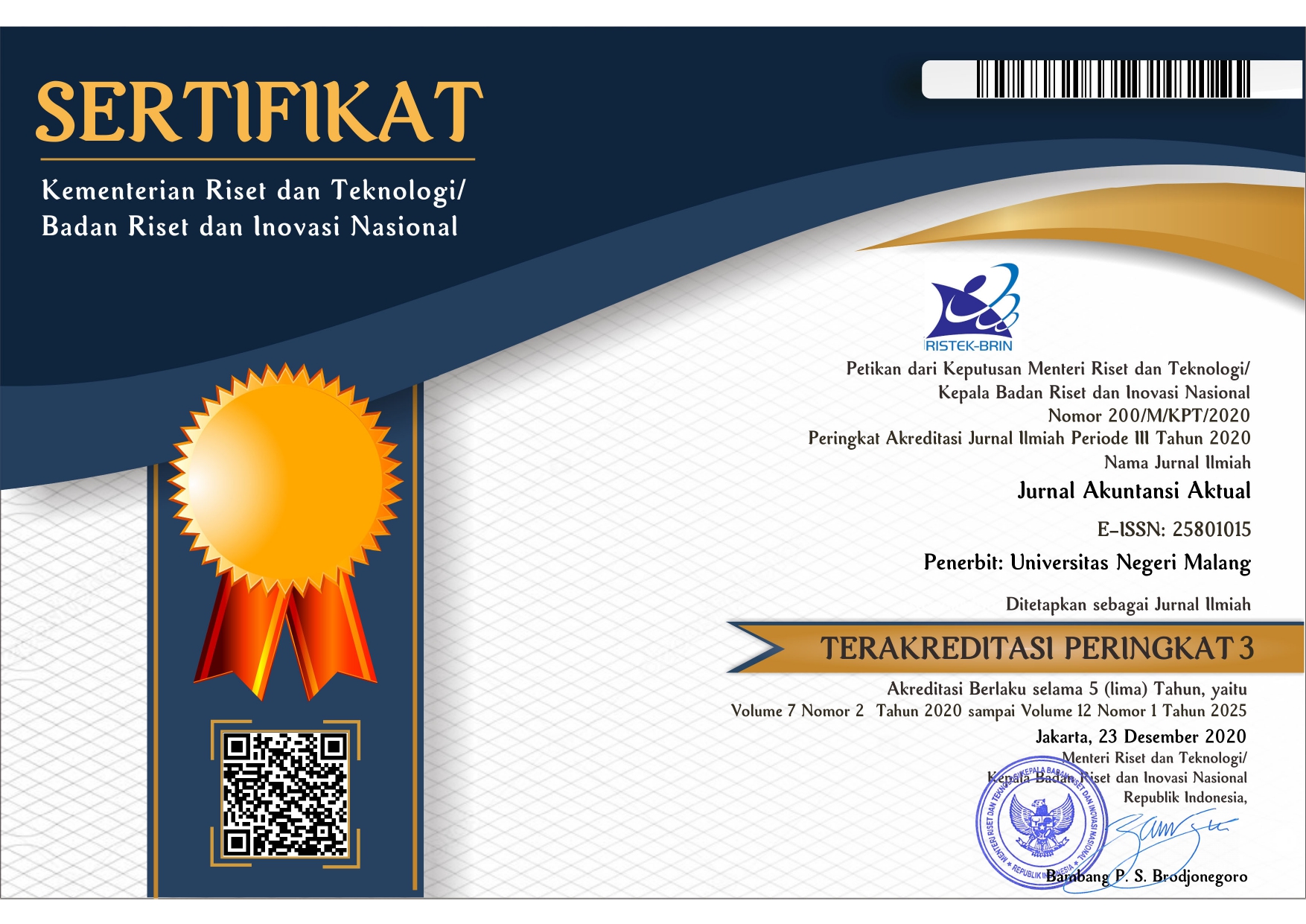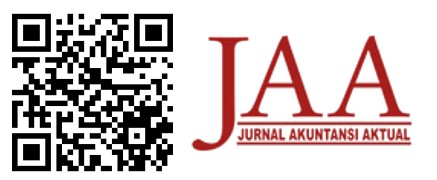The Determinants of Financial Statement Fraud: Fraud Pentagon Perspective
Abstract
Purpose:
This study investigates the determinants of financial statement fraud from the perspectives of fraud pentagon theory. It is important to study the issue within the context of state-owned companies (BUMN) as stakeholders pay a lot of attention on the companies.
Method:
This research is quantitative one, with a logistic regression analysis of the 16 BUMN's financial statements listed on the Indonesian Stock Exchanges for the period of five years (2018-2022). The F-Score model is adopted to measure the indications of fraudulent statement of the companies.
Findings:
The findings show that the five components of fraud pentagon theory do not fully determine the the indication of fraudulent financial statements of the companies. Only financial targets (FT) and CEO duality (CEOD) show significant values with negative relationship. This implies that on the context of BUMN, the five components of fraud pentagon theory do not play important roles in triggering fraudulent financial statements.
Originality/Value:
This paper stands out for being one of the few studies analyzing the arrogance component of fraud Pentagon theory using CEO duality. Most of previous studies on Pentagon fraud utilize CEO photographs to represent arrogance and result in inconsistent findings. Thus this paper extends current studies on the importance of using CEO duality as a proxy of arrogance.Keywords
Full Text:
PDFReferences
Achmad, T., Ghozali, I., Helmina, M. R. A., Hapsari, D. I., & Pamungkas, I. D. (2023). Detecting Fraudulent Financial Reporting Using the Fraud Hexagon Model: Evidence from the Banking Sector in Indonesia. Economies, 11(1), 1-17. doi:10.3390/economies11010005.
Achmad, T., Ghozali, I., & Pamungkas, I. D. (2022). Hexagon Fraud: Detection of Fraudulent Financial Reporting in State-Owned Enterprises Indonesia. Economies, 10(1), 1-16. doi:10.3390/economies10010013.
Agbaje, W. H. & Oloruntoba, S. R. (2018). An Assessment of Impact of Financial Statement Fraud on Profit Performance of Manufacturing Firm in Nigeria: A Study of Food and Beverage Firms in Nigeria. European Journal of Business and Management, 10(9), 1–16.
Akinbowale, O. E., Klingelhöfer, H. E., & Zerihun, M. F. (2023). Application of Forensic Accounting Techniques in the South African Banking Industry for the Purpose of Fraud Risk Mitigation. Cogent Economics and Finance, 11(1), 1-21. doi:10.1080/23322039.2022.2153412.
Alhadab, M., Abdullatif, M., & Mansour, I. (2020). Related Party Transactions and Earnings Management in Jordan: The Role of Ownership Structure. Journal of Financial Reporting and Accounting, 18(3), 505–531. doi:10.1108/JFRA 01 2019 0014.
Anadya, D. & Easter, L. (2023). Laporan Hasil Pemantauan Tren Penindakan Kasus Korupsi Tahun 2022 - Korupsi Lintas Trias Politika. Indonesia Corruption Watch. https://antikorupsi.org/sites/default/files/dokumen/Narasi Laporan Tren Penindakan Korupsi Tahun 2022.pdf.
Aprian, F. H., Fauzi, A., & Mardi. (2023). The Effect of Financial Stability, Nature of Industry and Total Accrual on Fraudulent Financial Statements. 2(2), 436–449. doi:10.55047/marginal.v2i2.578.
Association of Certified Fraud Examiners Indonesia. (2019). Survei Fraud Indonesia 2019. https://acfe-indonesia.or.id/survei-fraud-indonesia/.
Cabello, A., Moncarz, E., Moncarz, R., & Moncarz, B. (2009). The Rise and Collapse of Enron: Financial Innovation, Errors and Lessons. Contaduría y Administración, 218, 17-37. doi:10.22201/fca.24488410e.2006.579.
Cressey, D. R. (1953). Other People’s Money a Study in the Social Psychology of Embezzlement. Glencoe: Free Press.
Crowe Horwath. (2012). The Mind Behind the Fraudsters Crime: Key Behavioral and Environmental Elements. https://www.fraudconference.com/uploadedFiles/Fraud _Conference/Content/Course-Materials/presentations/23rd/ppt/10C-Jonathan-Marks.pdf.
Dechow, P. M., Ge, W., Larson, C. R., & Sloan, R. G. (2011). Predicting Material Accounting Misstatements. Contemporary Accounting Research, 28(1), 17–82. doi:10.1111/j.1911-3846.2010.01041.x.
Evana, E., Metalia, M., Mirfazli, E., Georgieva, D. V., & Sastrodiharjo, I. (2019). Business Ethics in Providing Financial Statements: The Testing of Fraud Pentagon Theory on the Manufacturing Sector in Indonesia. Business Ethics and Leadership, 3(3), 68–77. doi:10.21272/bel.3(3).68-77.2019.
Fathmaningrum, E. S. & Anggarani, G. (2021). Fraud Pentagon and Fraudulent Financial Reporting: Evidence from Manufacturing Companies in Indonesia and Malaysia. Journal of Accounting and Investment, 22(3), 625–646. doi:10.18196/jai.v22i3.12538.
Firnanti, F., Pirzada, K., & Budiman, B. (2019). Company Characteristics, Corporate Governance, Audit Quality Impact on Earnings Management. Accounting and Finance Review, 4(2), 43–49. doi:10.35609/afr.2019.4.2(2).
Ghozali, I. (2018). Aplikasi analisis multivariate dengan program IBM SPSS 25. Semarang: Badan Penerbit Universitas Diponegoro.
Gomes, P. (2012). Evidence of Earnings Management Using Accruals as a Measure of Accounting Discretion. Tékhne, 10(1), 3-14. doi:10.1016/S1645-9911(12)70002-6.
Hartanto, R., Lasmanah, L., Mustafa, M., & Purnamasari, P. (2019). Analysis of Factors That Influence Financial Statement Fraud In The Perspective Fraud Triangle: Empirical Study on Banking Companies In Indonesia. https://doi.org/10.4108/eai.18-7-2019.2288648
Hidayah, E. & Saptarini, G. D. (2020). Pentagon Fraud Analysis in Detecting Potential Financial Statement Fraud of Banking Companies in Indonesia. Proceeding of the 3 rd International Conference on Accounting, Business & Economics, 91-102.
Hosmer, D. W. & Lemeshow, S. (2000). Applied Logistic Regression. New York: John Wiley & Sons, Inc.
Husnurrosyidah, H. & Fatihah, I. (2022). Fraud Detecting Using Beneish M-Score and F Score: Which is More Effective?. Equilibrium: Jurnal Ekonomi Syariah, 10(1), 137-151. doi:10.21043/equilibrium.v10i1.15351.
Imen, F. & Anis, J. (2021). The Moderating Role of Audit Quality on the Relationship between Auditor Reporting and Earnings Management: Empirical Evidence from Tunisia. EuroMed Journal of Business, 16(4), 416–430. doi:10.1108/EMJB-03-2020-0024.
Ismael, H. R. & Kamel, H. (2020). Internal Audit Quality and Earnings Management: Evidence from the UK. Managerial Auditing Journal, 36(7), 951–978. doi:10.1108/MAJ-09-2020-2830.
Jensen, M. C. and Meckling, W. H. (1976). The Resource-Based View Within the Conversation of Strategic Management. Journal of Financial Economics, 13(3), 305–360. doi:10.1002/mde.l218.
Khamainy, A. H., Ali, M., & Setiawan, M. A. (2022). Detecting Financial Statement Fraud through New Fraud Diamond Model: The Case of Indonesia. Journal of Financial Crime, 29(3), 925–941. doi:10.1108/JFC-06-2021-0118.
Lokanan, M. & Sharma, S. (2018). A Fraud Triangle Analysis of the Libor Fraud. Journal of Forensic & Investigative Accounting, 10(2), 187–212.
Maharani, S. P., Supriatiningsih, Samukri, & Suryaningsih, M. (2023). The Influence of The S.C.C.O.R.E Model on Financial Statement Fraud in LQ-45 Indexed Companies with the Beneish M-Score Method. Iconic Research and Engineering Journals, 7(3), 24–35.
Maniatis, A. (2022). Detecting the Probability of Financial Fraud Due to Earnings Manipulation in Companies Listed in Athens Stock Exchange Market. Journal of Financial Crime, 29(2), 603–619. doi:10.1108/JFC-04-2021-0083.
Mcclure, B. (2021). How to Use ROA to Judge a Company’s Financial Performance. Investopedia. https://www.investopedia.com/articles/fundamental/04/012804.asp.
Mubeen, R., Han, D., Abbas, J., Álvarez-Otero, S., & Sial, M. S. (2021). The Relationship between CEO Duality and Business Firms’ Performance: The Moderating Role of Firm Size and Corporate Social Responsibility. Frontiers in Psychology, 12, 1–17. doi:10.3389/fpsyg.2021.669715.
Mulia, C. & Tanusdjaja, H. (2021). Analisis Fraud Diamond untuk Mendeteksi Terjadinya Financial Statement Fraud di Perusahaan Real Estate. Jurnal Kontemporer Akuntansi, 1(1), 10-19. doi:10.24912/jka.v1i1.15067.
Narew, I., Zuhroh, D., & Harmono. (2021). Analisis Diamond Fraud Theory dalam Mendeteksi Kecurangan Laporan Keuangan. Jurnal Akuntansi Trisakti, 8(2), 317-342. doi:10.25105/jat.v8i2.10129.
Neuman, W. L. & Djamba, Y. K. (2014). Social Research Methods: Qualitative and Quantitative Approaches. Teaching Sociology, 30(3). doi:10.2307/3211488.
Nurcahyono, N. & Hanum, A. N. (2023). Determinants of Academic Fraud Behavior: The Perspective of the Pentagon Fraud Theory. Proceedings of the 1st Lawang Sewu International Symposium on Humanities and Social Sciences 2022 (LEWIS 2022), 163-177. doi:10.2991/978-2-38476-078-7_18.
Primasari, N. S. & Wahyuningtyas, E. T. (2021). Analisis F-Score untuk Pendeteksian Window Dressing dengan Moderasi Manajemen Laba dan Cash Holding. E-Jurnal Akuntansi, 31(5), 1189-1200. doi:10.24843/eja.2021.v31.i05.p09.
Richardson, S. A., Sloan, R. G., Soliman, M. T., & Tuna, I. (2005). Accrual Reliability, Earnings Persistence and Stock Prices. Journal of Accounting and Economics, 39(3), 437–485. doi:10.1016/j.jacceco.2005.04.005.
Sari, M. P., Mahardika, E., Suryandari, D., & Raharja, S. (2022). The Audit Committee as Moderating the Effect of Hexagon’s Fraud on Fraudulent Financial Statements in Mining Companies Listed on the Indonesia Stock Exchange. Cogent Business and Management, 9(1), 1–24. doi:10.1080/23311975.2022.2150118.
Sasongko, N. & Wijayantika, S. F. (2019). Faktor Resiko Fraud terhadap Pelaksanaan Fraudulent Financial Reporting (Berdasarkan Pendekatan Crown’S Fraud Pentagon Theory). Riset Akuntansi dan Keuangan Indonesia, 4(1), 67–76. doi:10.23917/reaksi.v4i1.7809.
Shonhadji, N. & Irwandi, S. A. (2023). Fraud Prevention in the Indonesian Banking Sector Using Anti-Fraud Strategy. Banks and Bank Systems, 19(1), 12–23. doi:10.21511/bbs.
Sihombing, K. S. & Rahardjo, S. N. (2014). Analisis Fraud Diamond dalam Mendeteksi Financial Statement Fraud: Studi Empiris pada Perusahaan Manufaktur yang Terdaftar di Bursa Efek Indonesia (BEI) Tahun 2010 – 2012. Diponegoro Journal of Accounting, 3(2), 1-12. doi:10.25105/semnas.v0i0.5780.
Sitanggang, R. P., Karbhari, Y., Matemilola, B. T., & Ariff, M. (2020). Audit Quality and Real Earnings Management: Evidence from the UK Manufacturing Sector. International Journal of Managerial Finance, 16(2), 165–181. doi:10.1108/IJMF-03-2018-0095.
Situngkir, N. C. & Triyanto, D. N. (2020). Detecting Fraudulent Financial Reporting Using Fraud Score Model and Fraud Pentagon Theory: Empirical Study of Companies Listed in the LQ 45 Index. The Indonesian Journal of Accounting Research, 23(03), 373–410. doi:10.33312/ijar.486.
Skousen, C. J., Smith, K. R., & Wright, C. J. (2009). Detecting and Predicting Financial Statement Fraud: The Effectiveness of the Fraud Triangle and SAS No. 99. Corporate Governance and Firm Performance, 23(3), 373-410. doi:10.1108/S1569-3732(2009)0000013005.
Tiffani, L. & Marfuah. (2015). Deteksi Financial Statement Fraud dengan Analisis Fraud Triangel pada Perusahaan Manufaktur yang Terdaftar di Bursa Efek Indonesia. Jurnal Akuntansi dan Auditing Indonesia, 19(2), 112–125. doi:10.20885/jaai.vol19.iss2.art3.
Troy, S. (2023). Enron Scandal: The Fall of a Wall Street Darling. Investopedia. https://www.investopedia.com/updates/enron-scandal-summary/.
Widyasari, P. A., Harindahyani, S., & Rudiawarni, F. A. (2017). Strategi Bisnis dalam Praktik Manajemen Laba pada Perusahaan Manufaktur di Indonesia. Jurnal Keuangan dan Perbankan, 21(3), 397–411. doi:10.26905/jkdp.v21i3.1179.
Wolfe, D. T. & Hermanson, D. R. (2004). The Fraud Diamond: Considering the Four Elements of Fraud. The CPA Journal, 7(12), 38-42.
Wu, H., Chang, Y., Li, J., & Zhu, X. (2021). Financial Fraud Risk Analysis Based on Audit Information Knowledge Graph. Procedia Computer Science, 199, 780–787. doi:10.1016/j.procs.2022.01.097.
Wu, P., Gao, L., & Gu, T. (2014). Business Strategy, Market Competition and Earnings Management: Evidence from China. Chinese Management Studies, 9(3), 401–424. doi:10.1108/CMS-12-2014-0225.
DOI: http://dx.doi.org/10.17977/um004v11i12024p019
Refbacks
- There are currently no refbacks.

This work is licensed under a Creative Commons Attribution-ShareAlike 4.0 International License.
Jurnal Akuntansi Aktual is indexed by:















